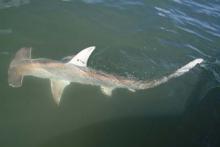You are here
Wide ranging survey highlights shark biodiversity

The Great Barrier Reef shark population is highly diverse and inshore areas in the central section of the marine park play an important role for both juvenile and adult sharks. These are the main findings of a preliminary survey along the central GBR coast.
Sharks face pressure from fishing and other human activities. Inshore areas, which are important nursery areas for a range of shark species, have the added challenge of being prone to the effects of freshwater discharge from coastal streams or rivers, which can affect how sharks use these areas.
The survey, part of NERP project 6.2, was carried out over 600 km of the coastline between Cardwell and Proserpine. Project leader, Dr Colin Simpfendorfer, from the Centre for Sustainable Tropical Fisheries and Aquaculture at James Cook University, said the results show that sharks need to be managed along the whole GBR coastline.
“We can’t just set one area aside to look after sharks because different sharks make use of different areas,” Dr Simpfendorfer said.
“Some species use these inshore areas as nurseries where their young are born and live for some time – the shallow waters may provide food and a refuge from predators. Other species use the coastal waters throughout their lifetime or visit seasonally.”
He said the research is showing that some sections of the coast can be grouped together by the sharks that occur there and their environmental characteristics.
A total of 529 sharks and rays from 11 families were captured during the survey. Of these, 84% were sharks, most of which were tagged and released. Of the 24 different species caught, the most common were the Australian sharpnose (47%), blacktip sharks (15%), spot-tail sharks (10%) and pigeye sharks (7%).
This is the first time such a wide ranging survey has been undertaken. Previous surveys have focused on single locations. Smaller surveys will be carried out every quarter for the next two years over parts of the same area to build a better picture of shark diversity along the coast.
For more information please contact Dr Colin Simpfendorfer, James Cook University, colin.simpfendorfer@jcu.edu.au
See more information about this project here
Latest News
- Laws protecting the Great Barrier Reef to be introduced next week, Queensland Premier says - Thu 28th May 2015
- Let’s get serious about protecting wildlife in a warming world - Thu 28th May 2015
- We’ve only monitored a fraction of the Barrier Reef’s species - Thu 28th May 2015
- Great Barrier Reef: warmer waters helping coral-eating starfish thrive - Fri 13th Feb 2015
- You are what you eat—if you're a coral reef fish - Wed 17th Dec 2014


